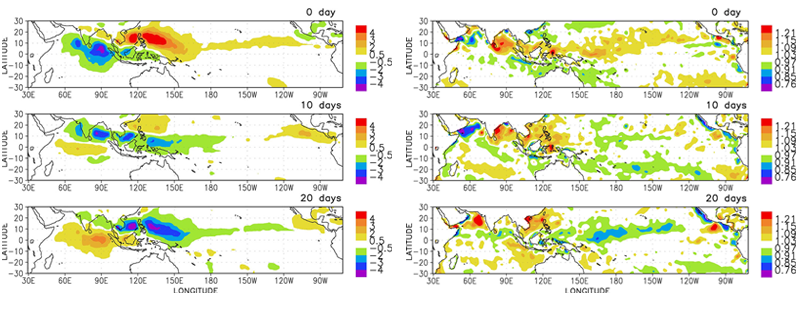The MJO and Ocean Chlorophyll
by Duane Waliser
Could MJO Predictions Be of Use to the Fishing Industry?
Motivation
The MJO has been shown to have important influences on ocean surface fluxes of momentum, heat (e.g., radiation, latent heat flux), and mass (i.e. evaporation and precipitation). These influences have been shown to produce significant variations in physical properties of the near-surface ocean (e.g., SST, mixed-layer depth), which have been hypothesized, and in some model settings demonstrated, to feedback to the atmosphere/MJO. These issues raise the question of whether the influences extend to biogeochemical processes in the ocean, for example ocean bio-productivity.
Research Summary
Analysis of satellite ocean color and rainfall data shows that the MJO produces systematic and significant variations in ocean surface Chlorophyll (Chl) in a number of regions across the tropical Indian and Pacific Oceans. The results are seasonally dependent, with the main regions of variation in boreal summer (see figure) being the northern Indian Ocean, a broad expanse of the northern tropical Pacific Ocean and a number of regions in the far eastern Pacific Ocean. In the boreal winter, MJO-induced variations are strongest in the northwest Indian Ocean, over broad areas of the western and central Pacific, and coastal Mexico. Examination of the corresponding surface wind data indicates that vertical entrainment of nutrients at the base of the ocean mixed layer is an important contributing mechanism.

Madden Julian Oscillation (MJO). Lags start at 0 days (top), +10 days (middle) and +20 days (bottom), which together account for about one half of a complete MJO event. Right panel: same, except for ocean surface Chlorophyll from SeaWiFS, where the values are normalized by the seasonal means (e.g., 1.2 idicates 120% of the N. H. summer mean).
Implications
Given evidence that the MJO is predictable with 2-3 week lead-times, surface Chl may also be predictable at similar lead times with implications for the fishing industry and public health sectors concerned with cholera epidemics.
Future Work
Two avenues of further investigation include: 1) examine historical fish-catch data to determine if the influence of the MJO on Chl extends to an impact on fish abundance, and 2) use bio-physical ocean models with satellite data to determine more specifically the mechanisms responsible for the observed MJO-Chl relationship.
Reference
Waliser, D. E., R. Murtugudde, P. Strutton, J.-L. Li, 2005, Subseasonal Organization of Ocean Chlorophyll: Prospects for Prediction Based on the Madden-Julian Oscillation, Geoph. Res. Lett., 32, L23602, doi:10.1029/2005GL024300.
